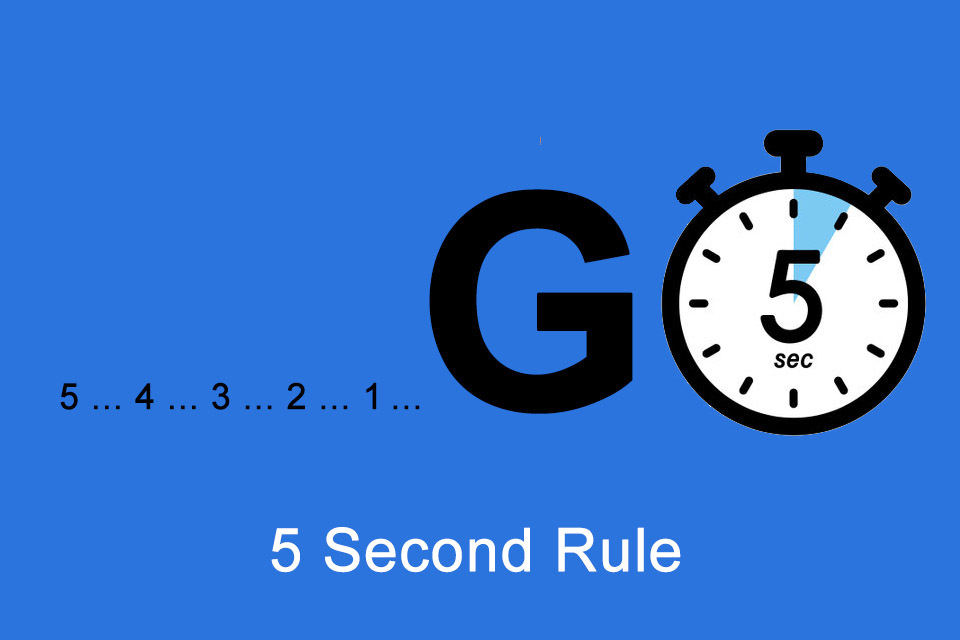What is the 5 Second Rule?
Smartpedia: The 5 Second Rule is a technique in self-management that reinforces an impulse to move from thinking to action before objections prevent it.
5 Second Rule – a technique in self-management
The 5 Second Rule is a self-management technique. It advocates that people should start completing a possibly unpleasant task within 5 seconds, otherwise they may try to postpone the completion of the task. The technique thus tries to strengthen an impulse to move from thinking to action before objections prevent this.
The 5 Second Rule goes to Mel Robbins, an American television presenter, author and motivational speaker and her book “5…4…3…2…1…Go! The 5 Second Rule”. In contrast to the 2 Minute Rule of David Allen, an expert for self-management, Mel Robbins addresses internal obstacles with her rule, which are often described as procrastination. David Allen’s considerations are aimed at tasks that can be completed within 2 minutes – so the two approaches differ fundamentally.
The impulse for 5…4…3…2…1…Go!
According to Mel Robbins, you should do the following as soon as you feel an impulse, an obligation or even a wish to complete a task:
Count backwards from 5 to 1. And get going. 5…4…3…2…1. Go!
By this active counting backwards – the countdown – you bring the momentum to your side and strengthen the impulse before you think about obstacles and possible excuses. Don’t follow your initial impulse within the 5 seconds, you probably won’t follow the impulse at all.
The elements of the 5 Second Rule
There are some aspects that need to be considered when applying the rule:
- An impulse is not irrational, it must not harm anyone. It is not about risk avoidance or ignoring experiences, it is more about a gut feeling or an intention.
- There is a connection between impulse and an important objective. Maybe you want to move more in a project, and you have an impulse in a meeting on how to move the project forward, follow that impulse and express your opinion.
- You need to get into action and possibly force yourself to do “something”. Maybe you want to earn more money and you have collected arguments for a conversation with your supervisor, then talk to your supervisor. There probably isn’t a “perfect moment”, but if you’re waiting for that moment to come on its own, or for your supervisor to give you more pay on his or her own, you might wait a long time.
- What you need is a “push” – and you give that push to yourself. If there is the impulse and the connection to a superior goal, then start the countdown: 5…4…3…2…1…Go!
- After the mental push follows the physical movement. Reach for the telephone receiver and call the “difficult customer”, go to your colleague and tell him your opinion. Maybe it is even the other way around and the physical movement prevents you from doing something, e.g. don’t react to an insult.
It is important that you get started within 5 seconds – theoretically in 4 or 3 seconds, depending on your level of practice. If you are unable to react actively to an impulse, the impulse will pass and nothing will change. Maybe this is certain in a way, but it is – at least according to Mel Robbins – not effective.
Criticism of the 5 Second Rule
In the context of the 5 Second Rule, there are some critical remarks and questions:
- What influence does the scope of a task have? What is the relationship between the priority of a task and a “new” impulse?
- Experience shapes people and their behaviour. People avoid “actions” e.g. to protect themselves. Is it possible (and useful) to throw experiences overboard within 5 seconds?
- Procrastination is a pathological disorder, possibly the 5 Second Rule is not the appropriate measure to remedy this disorder.
- What (scientifically reliable) proof of effectiveness is there that the rule contributes permanently to a change in behaviour? And is the change in behaviour positive?
In a nutshell: The 5 Second Rule tries to encourage people to move from thinking to acting. Changes often happen in small steps and this technique improves self-management in small steps. You could try it yourself: it only takes 5 seconds.
Impulse to discuss
Is the approach also suitable for activities that are taken on by a team?
Here you will find more information about Mel Robbins (videos, books, blogs).
If you like the article or would like to discuss it, please feel free to share it in your network. And if you have any comments, please do not hesitate to send us a message.
And here you will find additional information from the t2informatik Blog:



